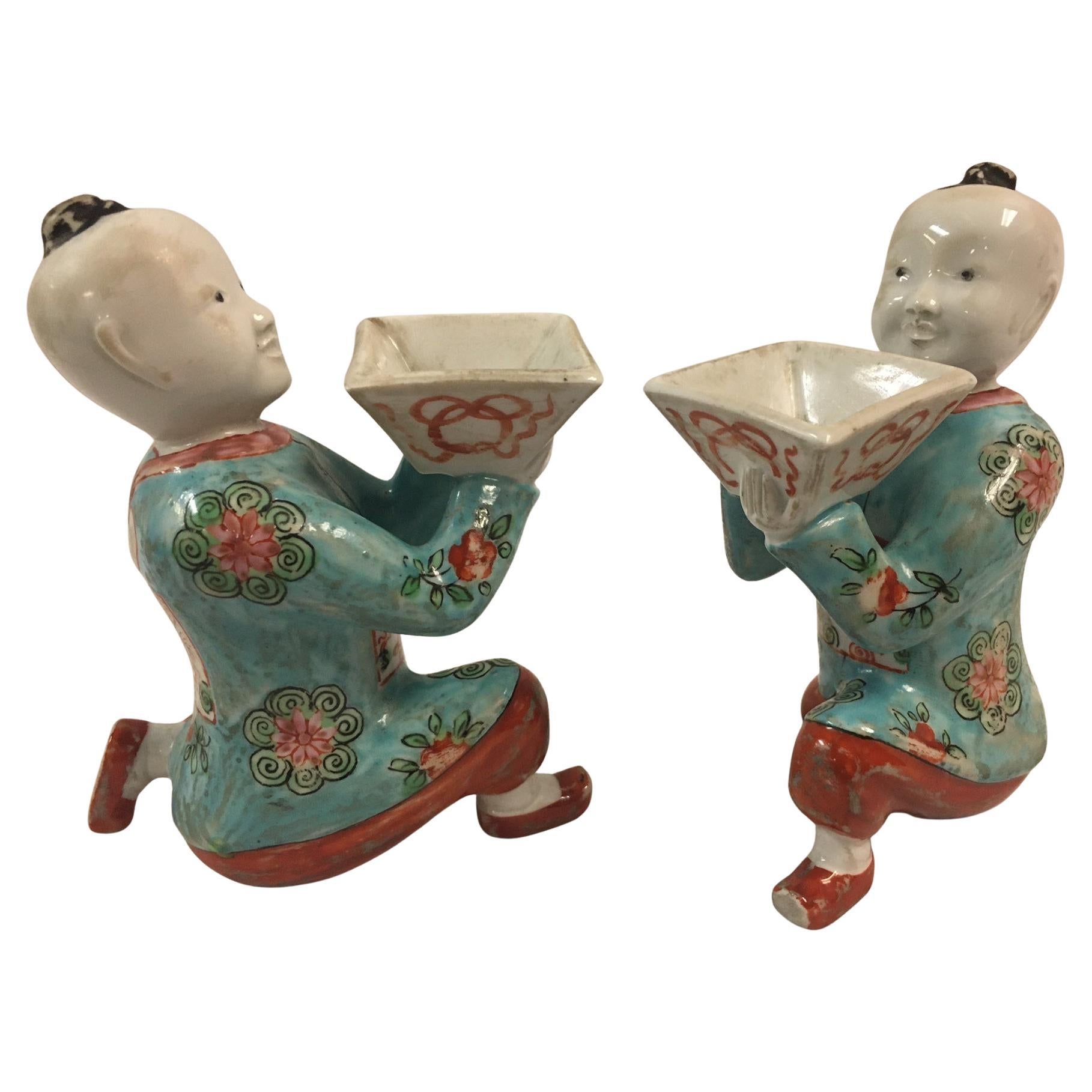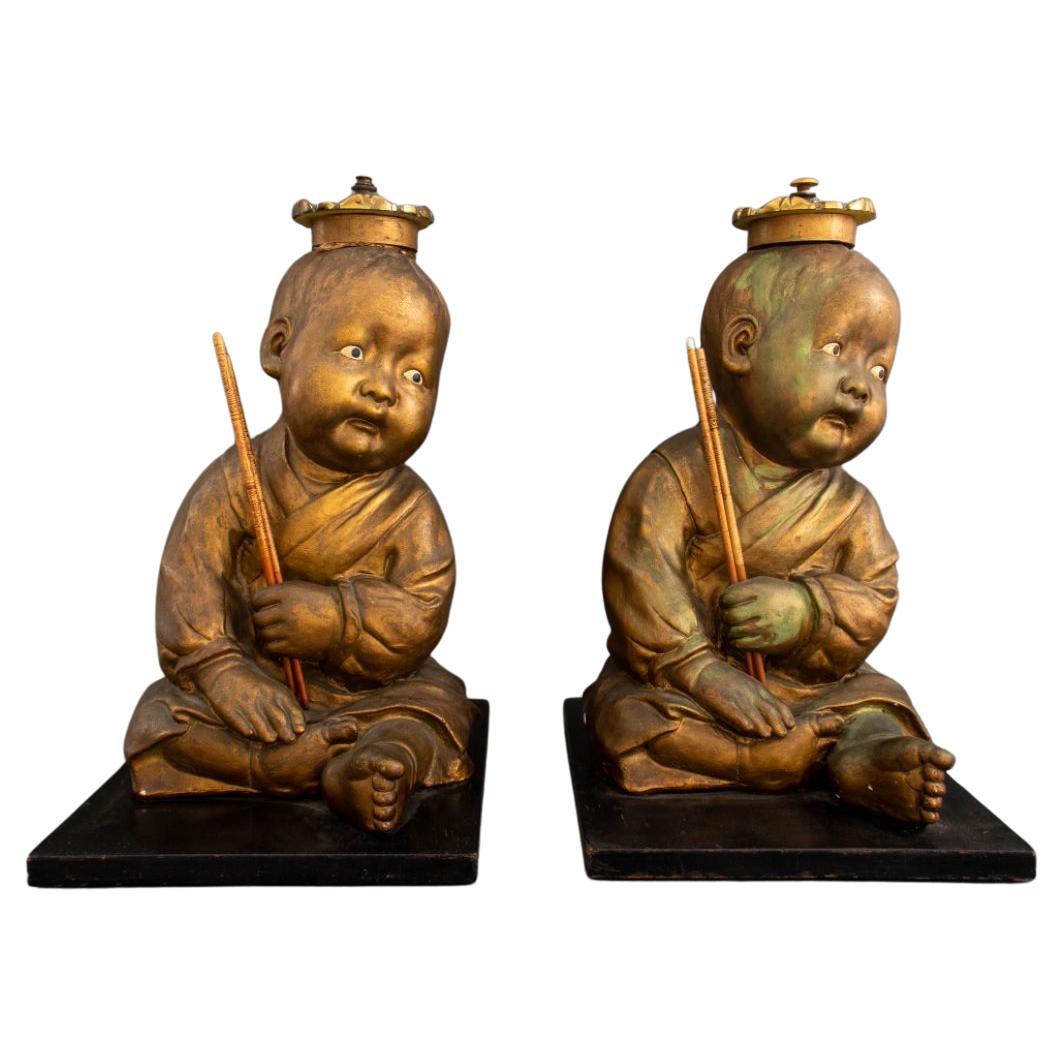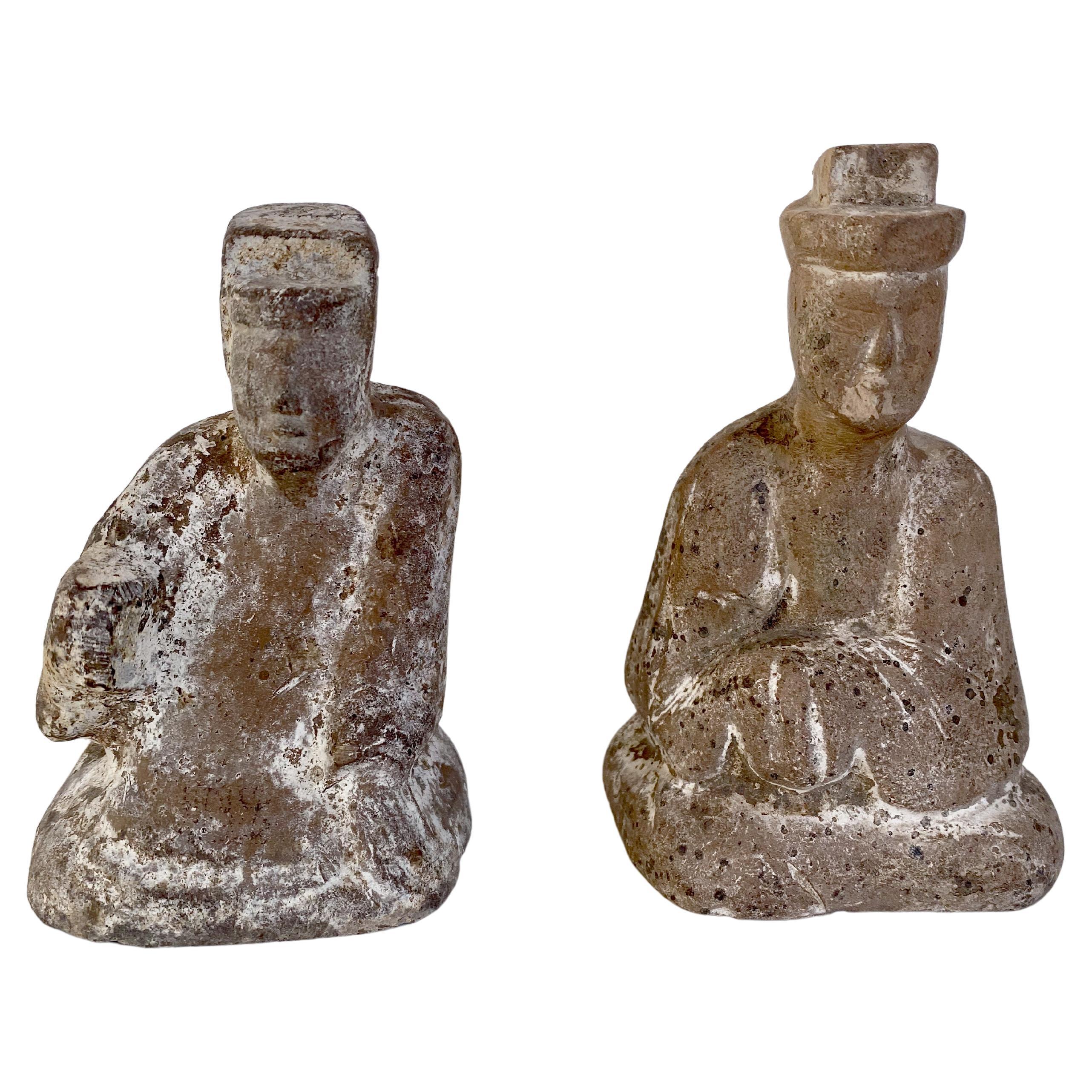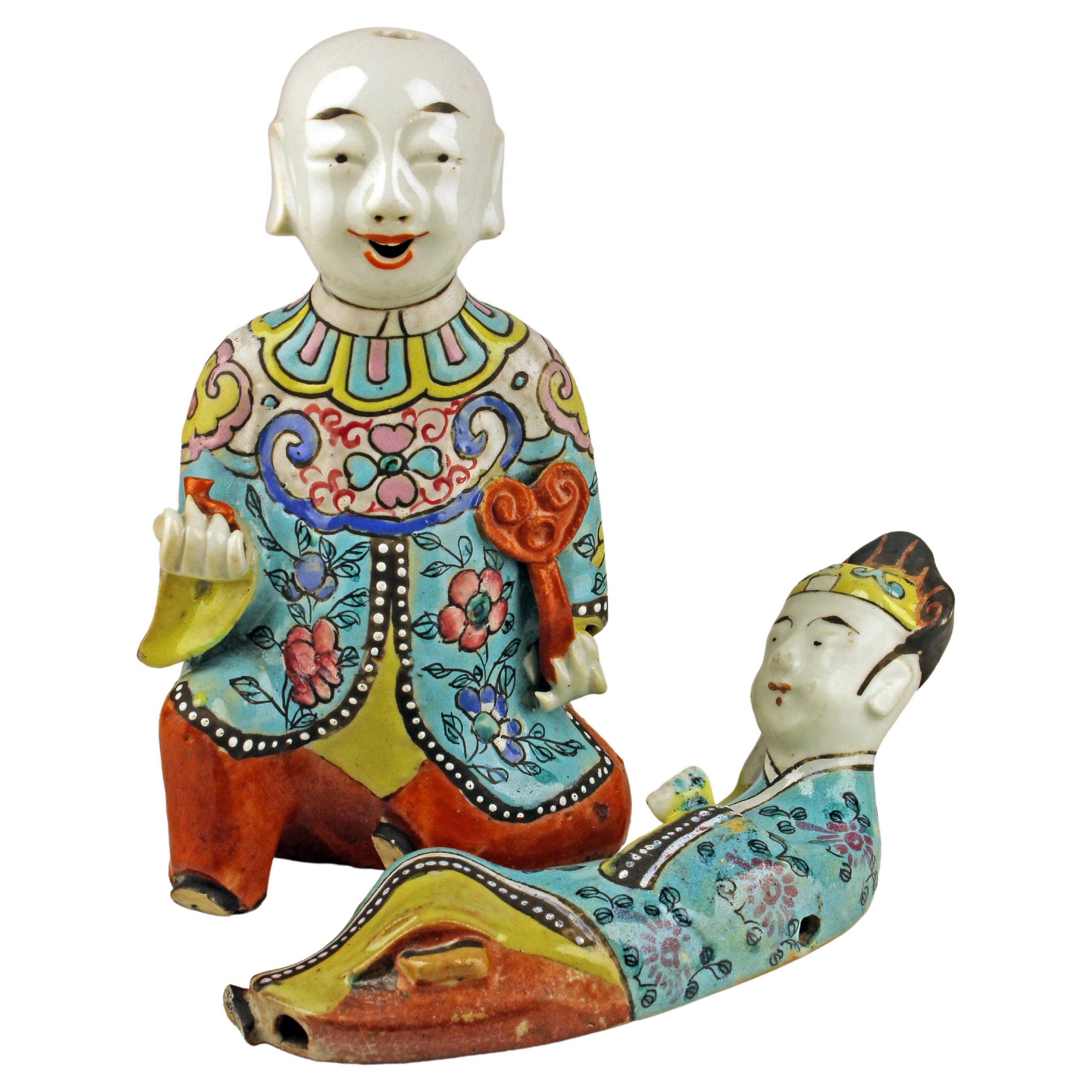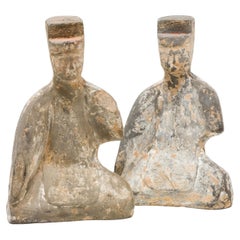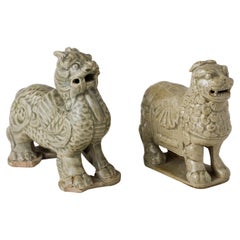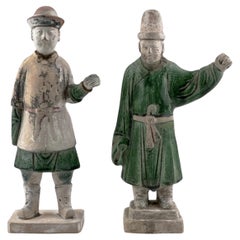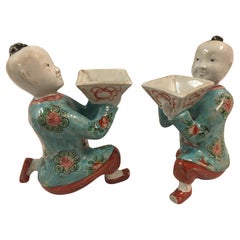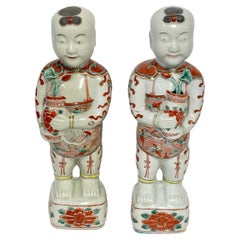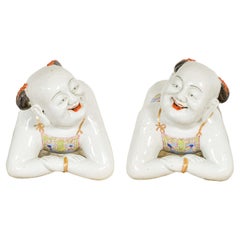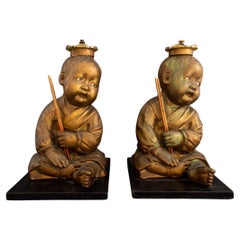Items Similar to Two Figurine of Seated Boys, Circa 1725, Qing Dynasty, Yongzheng Reign
Want more images or videos?
Request additional images or videos from the seller
1 of 18
Two Figurine of Seated Boys, Circa 1725, Qing Dynasty, Yongzheng Reign
$1,300
£985
€1,130.21
CA$1,829.31
A$2,010.91
CHF 1,056.84
MX$24,419.83
NOK 13,183.87
SEK 12,490.79
DKK 8,435.01
About the Item
Wearing a blue-glazed short child's apron knotted around the waist, his hair drawn into one or two topknots
Period : Qing Dynasty, Yongzheng Period
Production Date : C 1725
Made in : Jingdezhen
Destination : Netherland
Found/Acquired : Southeast Asia , South China Sea, Ca Mau ship
Reference : Double checked with reference to the original catalogues
1) Tau Co Ca Mau(The Ca Mau Shipwreck) Catalogue 2002 / The National Museum of Vietnamese History
2) THE CA MAU SHIPWRECK PORCELAIN : from the Collection of Dr.Zelnik , 2000
3) Sotheby’s Amsterdam, 2007 : Made In Imperial China / Sotheby's
4) Asian Ceramic Found along Maritime Silk Route / National Maritime Museum of Korea
* The Ca Mau Cargo
The Ca Mau Cargo refers to a Chinese cargo sunken sometime between 1723 and 1735 off the coast of Vietnam’s farthest point in the South China Sea, discovered by Vietnamese fishermen in 1998. It is believed the ship was a Chinese merchant’s cargo on its way from Canton (Guangzhou) to Batavia when it caught fire and sank. The merchant had ordered the goods on board for Dutch traders, who had limited access to China and its ports.
* Porcelain for the European Market
The Ca Mau Cargo consisted of numerous types of porcelain, chinaware and blue and white wares, all designed for the European market. Blue and white ceramics recovered from the cargo appear decorated with the so-called ‘Scheveningen landscape’, also known as ‘Deshima décor’. This motif usually depicted a traditional Dutch fishing village, executed in Chinese style. Chinese wares with Western motives were extremely popular and made to order and were known as ‘China de commande’.
- Dimensions:Height: 3.35 in (8.5 cm)Diameter: 1.97 in (5 cm)
- Style:Chinoiserie (Of the Period)
- Materials and Techniques:Ceramic,Glazed
- Place of Origin:
- Period:1720-1729
- Date of Manufacture:1725
- Condition:Minor fading.
- Seller Location:seoul, KR
- Reference Number:1stDibs: LU9577237560192
About the Seller
4.8
Gold Seller
Premium sellers maintaining a 4.3+ rating and 24-hour response times
Established in 1999
1stDibs seller since 2023
44 sales on 1stDibs
Typical response time: 4 hours
- ShippingRetrieving quote...Shipping from: seoul, Korea South
- Return Policy
Authenticity Guarantee
In the unlikely event there’s an issue with an item’s authenticity, contact us within 1 year for a full refund. DetailsMoney-Back Guarantee
If your item is not as described, is damaged in transit, or does not arrive, contact us within 7 days for a full refund. Details24-Hour Cancellation
You have a 24-hour grace period in which to reconsider your purchase, with no questions asked.Vetted Professional Sellers
Our world-class sellers must adhere to strict standards for service and quality, maintaining the integrity of our listings.Price-Match Guarantee
If you find that a seller listed the same item for a lower price elsewhere, we’ll match it.Trusted Global Delivery
Our best-in-class carrier network provides specialized shipping options worldwide, including custom delivery.More From This Seller
View AllTwo Pottery Kneeling Figures of Attendant
Located in seoul, KR
The statuette shows traces of the original red, black, and white pigmentation. Ceramic statuette from the han Dynasty, depicting two court people, probably a musician. They are dress...
Category
Antique 15th Century and Earlier Hong Kong Han Antiquities
Materials
Pottery
$3,790 / set
Rare Yue Celadon-Glazed Two Haitai Statues, Western Jin dynasty (265-420)
Located in seoul, KR
The statue seems to be a mythical beast standing in a poised and alert stance, with its mouth open as if roaring or breathing fire. Its body is covered in detailed carvings that resemble scales and feathers, indicative of the high level of craftsmanship during the Jin Dynasty. The creature’s presence is both regal and intimidating, suggesting it might have been believed to possess protective properties.
Period : Western Jin Dynasty (266 - 316 AD)
Type : Haitai Statue
Medium : Yue celadon...
Category
Antique 15th Century and Earlier Hong Kong Chinese Export Antiquities
Materials
Celadon
Two Figures of Attendants, Ming Period(1368-1644)
Located in seoul, KR
Statues of attendants crafted from terracotta, featuring glazes in green, Set on rectangular bases.
Period: Ming Dynasty
Medium: Glazed Pottery
Type: Figure
Condition : Excellent(It has soil on it, which is presumed to be evidence of excavation)
Provenance : Acquired in late 1990s from Hongkong
Reference :
1) Indianapolis Museum of Art - Dinastia ming, figure maschili, 1368-1644
(Type : Closely related)
2) V&A Museum - Accession number FE.295:1, 2-2005
(Type : Closely related)
3) Sotheby's 01 May 2007 - The Collection Of Paul Otto Taubert & Jewellery And Decorative Arts - Lot 233
(Price range : 5,000 - 7,000 AUD / Type : Closely related)
4) Asian Art Museum, San Francisco - Object number B60P1631 - Standing Man Tomb Figure
* Ming Dynasty Glazed Pottery Figures
Ming Dynasty glazed pottery figures are renowned for their bold color palette, intricate detailing, and lifelike forms, distinguishing them from earlier traditions. These figures, which depict officials, warriors, animals, and mythical creatures, are characterized by high-gloss lead-based glazes in green, amber, ochre, and sancai (three-color) combinations. The thickly applied glaze pools in recesses, creating depth and enhancing sculptural details. With dynamic postures, expressive facial features, and meticulously rendered drapery, these figures reflect the period’s advancement in ceramic craftsmanship, offering a greater sense of movement and realism compared to the rigid and stylized forms of earlier dynasties.
A defining characteristic of Ming glazed pottery is its elaborate surface detailing, often achieved through raised relief elements and contrasting glazes. Equestrian figures, for example, feature carefully sculpted saddles, harnesses, and decorative embellishments, while human figures are adorned with intricate robes and headdresses. The large scale of these tomb figures, often more imposing than those from previous periods, underscores the increasing importance of funerary art during the Ming era. Unlike later Qing Dynasty figures...
Category
Antique 15th Century and Earlier Hong Kong Ming Antiquities
Materials
Pottery
Two Glazed Court Attendants, Ming Period (1368-1644)
Located in seoul, KR
Two finely hollow-moulded terracotta statuettes from ancient China, dating to the Ming Dynasty. The figure is depicted standing, dressed in long, flowing robes, painted in vibrant blue or green and deep amber yellow. The hair is styled into an elaborate top-knot, painted in a muted brown. Areas left unpainted would have been 'cold-painted' after firing, contrasting with the vivid fired blue or green and amber pigments. The figure is shown with the left hand raised to the chest, as if holding something, possibly an offering or incense. Figurines like this were placed in tombs to guide the deceased on their journey to the afterlife.
The Ming Dynasty was known for its exceptional artistic achievements, partly due to its economic prosperity. Since the Han Dynasty, it was customary to bury terracotta miniatures of everyday objects with the deceased. These items, known as mingqi, or "spirit utensils" and "vessels for ghosts," were believed to help and assist the deceased in the afterlife. Mingqi were crafted in the form of cooking utensils, miniature replicas of houses, temples, furniture, and other items. Anthropomorphic and zoomorphic terracotta figures were also popular, designed to assist, entertain, and recreate the living world for the deceased.
Period: Ming Dynasty
Medium: Green/blue-glazed Pottery
Type: Figure
Provenance : Acquired in late 1990s from Hongkong
Reference :
1) Ancient & Oriental - Terracotta Tomb Attendants
(Type : Highly related)
2) La Maison De La Petite Sara S.r.l. - Archaeology section - A Black glazed Terracotta Statuette, Servant with Trumpet, Ming Dynasty
(Price realised : 700 GBP / Type : Highly related)
* Ming Dynasty Glazed Pottery Figures
Ming Dynasty glazed pottery figures are renowned for their bold color palette, intricate detailing, and lifelike forms, distinguishing them from earlier traditions. These figures, which depict officials, warriors, animals, and mythical creatures, are characterized by high-gloss lead-based glazes in green, amber, ochre, and sancai (three-color) combinations. The thickly applied glaze pools in recesses, creating depth and enhancing sculptural details. With dynamic postures, expressive facial features, and meticulously rendered drapery, these figures reflect the period’s advancement in ceramic craftsmanship, offering a greater sense of movement and realism compared to the rigid and stylized forms of earlier dynasties.
A defining characteristic of Ming glazed pottery is its elaborate surface detailing, often achieved through raised relief elements and contrasting glazes. Equestrian figures, for example, feature carefully sculpted saddles, harnesses, and decorative embellishments, while human figures are adorned with intricate robes and headdresses. The large scale of these tomb figures, often more imposing than those from previous periods, underscores the increasing importance of funerary art during the Ming era. Unlike later Qing Dynasty figures...
Category
Antique 15th Century and Earlier Hong Kong Ming Antiquities
Materials
Pottery
Two Straw-Glazed Pottery Figures of Court Male and Female
Located in seoul, KR
This pair of straw-glazed pottery figures represents a male and female court attendant, both elegantly attired in period fashion. The female figure wears a flowing robe with draped f...
Category
Antique 15th Century and Earlier Hong Kong Tang Antiquities
Materials
Pottery, Straw
Two White Figure of Seated Hounds, Circa 1725, Qing Dynasty, Yongzheng reign
Located in seoul, KR
Fine porcelain figure of seated hounds. The mouth of the dog is open; the ears are flipped back; and there is a chain around the neck. The dog's bones are well depicted.
Period : Qi...
Category
Antique 1720s Vietnamese Chinoiserie Animal Sculptures
Materials
Ceramic
You May Also Like
Pair of Porcelain Kneeling Chinese Boys Holding Shallow Single Blossom Vessels
Located in Savannah, GA
This whimsical pair of porcelain figures depict kneeling Chinese boys holding square containers suitable for single blossoms. The symmetry is graceful from all angles and the color p...
Category
Antique 1880s Chinese Chinese Export Ceramics
Materials
Porcelain
Pair of Chinese Export Famille Verte Figures of the Hehe Erxian Twins
Located in West Palm Beach, FL
Pair of Chinese Export Famille Verte Figures of the Hehe Erxian Twins
19th Century or Older
Embrace the allure of Chinese porcelain with this fine Pair of Chinese Export Famille Ve...
Category
Antique 19th Century Chinese Chinese Export Ceramics
Materials
Porcelain
$2,240 Sale Price / set
20% Off
Pair of Qing Dynasty Period Porcelain Tong'zi Pillows Depicting Kneeling Boys
Located in Yonkers, NY
A pair of Qing Dynasty period porcelain Tong'zi pillows from the 19th century, in the form of kneeling boys. These Qing Dynasty period porcelain Tong'zi pillows, crafted in the 19th ...
Category
Antique 19th Century Chinese Qing Ceramics
Materials
Porcelain
American Chalkware Chinoiserie Seated Infants, 2
Located in Astoria, NY
Pair of American Chalkware Chinoiserie Seated Infant Sculptures, gilded on black wood bases, apparently unmarked. 17.5" H X 10.5" W x 12.25" D. Proven...
Category
20th Century American Chinoiserie Figurative Sculptures
Materials
Plaster, Wood
$550 Sale Price / set
42% Off
Pair of Han Dynasty Seated Figures
Located in Atlanta, GA
Pair of seated pottery figures, Han dynasty (2nd century BC to 2nd century AD). The taller of the two sits very still and upright, his hands folded into his sleeves, gazing straight ...
Category
Antique 15th Century and Earlier Chinese Antiquities
Materials
Pottery
$1,250 / set
Pair of Mid-19th Century/Qing Dinasty of Enameled Chinese Porcelain Figurines
Located in North Miami, FL
Pair of Mid-19th century/Qing dinasty enameled chinese porcelain figurines depicting a laughing boy kneeling and another lying down
By: unknown
Material...
Category
Antique Mid-19th Century Chinese Qing Ceramics
Materials
Enamel
More Ways To Browse
Sothebys 2000
Vietnam Sculptures
Vintage Dancer 1930s
Warrior Statue
Wooden Sculpture Man
Wooden Tribal Sculpture
A Cipriani
Antique Marble Ball
Art Nouveau Lady Sculpture
Bronze Dancer Statues
Bronze Sculptures 1990s
Bronze With Ivory
Bruno Zach Bronze
Buddha Indian
Chinese Bronze Statue
Female Stone Sculpture
Italian Mannequin
Jean Baptiste Clesinger
